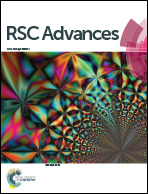DNAzyme catalytic beacons-based a label-free biosensor for copper using electrochemical impedance spectroscopy†
Abstract
In this study, we developed a novel selective method for copper quantification based on gold nanoclusters (GNCs) and DNAzyme. The GNCs were used as the sensing interface to immobilize with the DNAzyme capturing Cu2+ ions. The DNAzyme could be activated to cleave the substrate strand into two DNA fragments in the presence of Cu2+, and produce changes in the interfacial properties of the electrode. The difference in the interfacial electron-transfer resistance was probed in the presence of the reversible redox couple, Fe(CN)63−/4−, as a marker using electrochemical impedance spectroscopy (EIS). A Randles equivalent circuit was employed to evaluate the EIS results. The charge transfer resistance (RCT) of the Fe(CN)63−/4− redox indicator decreased remarkably after hybridization with Cu2+. The difference in RCT values before and after hybridization with Cu2+ showed a linear relationship with the concentration of Cu2+ in a range of 0.1–400 nM, with a detection limit of 0.0725 nM (S/N = 3). Furthermore, with the application of Cu2+ dependent DNAzyme, the proposed sensing system exhibited high selectivity. This biosensor demonstrated promising potential for Cu2+ detection in real samples.


 Please wait while we load your content...
Please wait while we load your content...